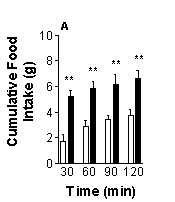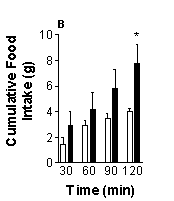| pA2
online © Copyright 2003 The British Pharmacological Society |
063P
University of Surrey Summer Meeting June 2003 |
|
Chronic administration of amphetamine alters the effect of the GABAB receptor agonist baclofen on food intake in rats
|
Print abstract Search PubMed for: |
It has been previously
reported that both central and systemic administration of the GABAB
agonist baclofen increases food intake in non-deprived rats (Ebenezer,
1990, Ebenezer et al., 1992). Recent evidence has suggested an
involvement of the mesolimbic dopamine system in the baclofen-induced
hyperphagic response (see Ward et al., 2000). As chronic administration
of amphetamine can alter (i) the firing pattern of neurones within the
mesolimbic system and (ii) GABAB
receptor transmission in the ventral tegmental area (VTA) where mesolimbic
dopamine neurones originate (see Wolf, 2002), the present study was undertaken
to investigate the effects of chronic administration of amphetamine on
baclofen-induced hyperphagia in rats.
Male Wistar rats (n=16; b. wt. 320 - 350g) were divided into two equal
groups. Rats in the Control Group received 12 once daily i.p.injections
of saline, while rats in the Test Group were treated with amphetamine
(5 mg kg-1, i.p.). Two days after the
end of the chronic treatment period, experimental sessions commenced.
Rats in the both groups were injected i.p.with either saline or baclofen
(2 mg kg-1). All rats received both treatments
in random order. Immediately after injection the rats were placed in experimental
cages with free access to food and water for 120 min, and food intake
measured and analysed as described previously (Ebenezer, 1990).
Fig. 1. Effect of baclofen on food intake in rats in the (A) Control Group
and (B) Test Group.
![]() Saline
Saline ![]() Baclofen (2 mg kg-1). Vertical line rep.
+ s.e.mean. *P<0.05, ** P<0.01 (paired t-test).
Baclofen (2 mg kg-1). Vertical line rep.
+ s.e.mean. *P<0.05, ** P<0.01 (paired t-test).


The results are
shown in Fig. 1. Rats in the both groups displayed a gradual increase
in food consumption under control conditions (saline) over the 120 min
measurement period. In the Control Group, baclofen produced significant
increases in cumulative food intake at the various measurement intervals
throughout the 120 min, with the greatest increase occurring during the
first 30 min (see Fig. 1A). By contrast, in the Test Group, the effects
of baclofen on food consumption followed a different pattern (see Fig.
1B). Baclofen did not significantly increases cumulative food intake at
30, 60 or 90 min, although the mean cumulative intake was higher than
that of controls. However, at 120 min there was a significant increase
in food intake. The data from this study indicates that chronic treatment
with amphetamine delays the hyperphagic effects of baclofen. Electrophysiological
studies have shown that firing rates of VTA dopamine neurones is increased
for several days after discontinuing repeated administration of amphetamine
(Wolf, 2002). Moreover, GABAB
receptor transmission is enhanced after withdrawal from amphetamine (Wolf,
2002). The present results therefore lend support to the suggestion that
the mesolimbic dopamine system may be involved in the hyperphagic effects
of baclofen.
Ebenezer, I.S. (1990) NeuroReport, 1, 73-76.
Ebenezer, I.S. et al. (1992) Neuropharmacol., 31,
39-42 .
Ward et al. (2000) Physiol. Behav., 68, 463-468.
Wolf, M.E. (2002) Mol. Interventions, 2, 146-157.